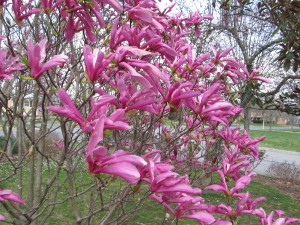The early flowering deciduous magnolias, namely star (Magnolia stellata) and tulip (M. soulangeana) magnolias, are often susceptible to late winter-early spring frosts. In the 1980’s the U.S. National Arboretum released the series of 8 shrub-type cultivars called the “Little Girl Magnolias”. They were crosses between M. liliiflora and M. stellata. Over ten years these deciduous shrubs will grow 10- 20 feet tall and wide.
Little Girl magnolias represent a great leap forward in developing a later flowering forms. Each cultivar blooms 7-10 days later in spring. The large goblet-shaped flowers are long tepals (petals and sepals) which measure 6 to 9 inches in length. ‘Ann’, ‘Betty’, ‘Susan’, and ‘Jane’ have been the popular choices among the eight introduced cultivars.
Flower colors vary by cultivar in pink to purple shades. Little Girl magnolias often surprise with occasional blooms through the spring and summer months. They are commonly large multi-stemmed shrubs, which can be easily trained into small trees. The deciduous leaves are thick and leathery and cope with summer’s heat and dry spells. With proper care and on the right planting site, magnolias are generally long-lived and disease and pest free.
Little Girl magnolias grow in moist, well-drained soils, preferably with a slightly acidic pH, and in full to partial sun (3 – 4 hours minimum sunlight). They do not tolerate flooding or wet feet. Prune spring flowering magnolias soon after the spring flowering flush is over. Prune to remove basal suckers and to maintain the desired shrub or tree form.
Magnolias can be easily started by layering a branch to the ground in the spring. Bend the flexible shoot to the ground and hold down with a heavy rock. By autumn a rooted shoot may be cut away from the main branch, dug up, and moved to its new garden location or gifted to a garden friend.


 Posted in
Posted in 
